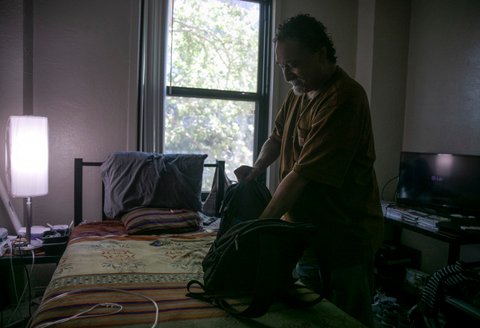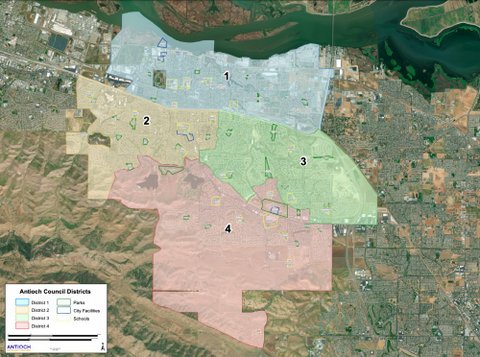
12 Jun Converting a Motel to Homeless Housing, Step By Step

Salvador Bradford tidies his studio at Hotel Berry. Bradford has been living in the one-room unit for 8 months and spends most of his time watching movies and keeping his room organized. Photo by Anne Wernikoff for CalMatters
By Matt Levin, CalMatters
Salvador Bradford takes pride in keeping his studio apartment relatively tidy.
He needs to. The converted hotel room he calls home has around 250-square feet of space to fit a bathroom, stove-top, and mini-fridge.
But there is space enough for the trappings of home: a shelf full of Star Wars and Star Trek DVDs, a small self-described “shrine” to Jesus Christ, to whom Bradford credits his past five years of sobriety.
He’s lived in the room at what was formerly the Hotel Berry in downtown Sacramento since last year and says his current twin mattress sure beats his past two years sleeping on the streets of San Francisco and Sacramento.
“It was horrible. I was dying, slowly but surely,” said Bradford, 64. “People (were) having sex in the alleyways, people (were) shooting up crystal meth.”
Gov. Gavin Newsom’s ambitious new plan to make a permanent dent in California’s homelessness crisis — more than 150,000 unhoused individuals, including more than 100,000 sleeping outside — would create hundreds of properties like the Hotel Berry, an 80-year-old motel transformed into 104 supportive housing units for the formerly homeless.
As part of ongoing budget negotiations with state lawmakers, Newsom wants to spend $600 million in federal emergency dollars to expand Project Roomkey, a joint state and federal program that has leased more than 15,700 hotel rooms for homeless Californians deemed especially susceptible to novel coronavirus. Roughly 9,600 of the rooms are currently occupied, according to an administration spokesman.
Phase two of the project is buying as many hotels or motels as possible for more permanent homeless housing by the end of the year, when the $600 million must be spent or be returned to the feds.
California has never tried buying so many properties to house its homeless population in such a short period of time. Affordable housing builders say they’re generally excited about Newsom’s proposal, which according to the administration’s preliminary, rough cost estimates could purchase as much as 6,000 units of new housing.
But veterans of these types of motel conversions also warn the process is more complicated, time-consuming and expensive than the average Californian might think. What Newsom wants to do in six months often takes years — and that’s before anyone starts swinging a hammer.
“We have to figure out how to make this work in the most efficient way possible,” said Ray Bramson, chief impact officer with Destination: Home, a nonprofit that provides homeless housing in Silicon Valley. “And it’s going to require some creativity.”
Here’s how motels are typically converted to more permanent homeless housing, step by painstaking step, and how the Newsom administration hopes to take those steps as speedily — and inexpensively — as possible.
Step 1: Buy the hotel
- Cost: $100,000-$175,000 per room, but varies across the state.
- Time: 2-3 months negotiations, not including escrow.
When the owner of a 70-room Econo Lodge motel in a lower-middle-class part of west Anaheim decided he wanted to retire in 2017, Vicky Ramirez sensed an opportunity.
Her team at Irvine-based Jamboree Housing had been eying properties in the region for permanent supportive housing. Orange County has an estimated 6,900 people experiencing homelessness, and cities within the fifth largest county in the country had been feuding with one another over where homeless housing should and shouldn’t be located.
In roughly three months, Ramirez negotiated a purchase and sale agreement with the owner: $9.2 million for the 1 acre property, or $130,000 per unit.
Land isn’t cheap in California, especially in high-cost coastal regions where the state’s homeless population is disproportionately located.
Data provided by the California Hotel and & Lodging Association, a hospitality industry advocacy group, indicate hotels that could be targeted by the state — think budget chains like Motel Six or smaller, independent motels with 150 units or less — regularly fetch over $100,000 per unit in Los Angeles County. A 40-room Travel Plaza in Compton sold for $4.5 million last year; a 21-unit Budget Inn on Sunset Boulevard, $2.8 million.
Costs just get steeper in the Bay Area. Bramson, who is helping developers explore motel conversions in Santa Clara County, says some properties can run as much as $17 million an acre.
Low-income housing developers caution that prices vary considerably from region to region and according to the quality of motel. Extended stay hotels that come pre-furnished with kitchenettes will be more expensive than deteriorating single-room-occupancy motels, which may be cheaper upfront but will require more rehab or outright demolition to turn into supportive housing.
The Newsom administration is tentatively budgeting $100,000 to $150,000 per unit, according to an administration official not authorized to comment publicly. They’re hoping a glut of hotel owners, pummeled by the pandemic-induced collapse of tourism, will gladly exit the industry. That, combined with a recession-induced dip in commercial real estate prices, could mean a once-in-a-generation bargain.
Lynn Mohrfeld, president of the California Hotel & Lodging Association, says the state won’t be competing against the typical bidders for hotel properties — larger hotel chains — because those companies aren’t in acquisition mode right now.
But he cautions that for the owners of many hotels participating in Project Roomkey — the very properties the state wants to target first — selling is a very different proposition than a temporary lease.
“These are closely held, long-term assets and unless the economics really force their hand and they can’t make their mortgages and foreclosure is knocking on the door, I don’t think the state is going to walk in and buy a hotel for a song,” Mohrfeld said.
The higher the purchase price, the fewer the number of units of homeless housing California can acquire.
Step 2: Get approval from the city
- Cost: Hard to quantify, but the quicker the cheaper.
- Time: 1-2 years, but much quicker if the governor gets his way.
Price is typically less of a sticking point in getting a motel owner to sell than the prolonged escrow period requested by homeless housing developers. Property sale limbo typically lasts between a year and eighteen months.
Why does it take so long? Because nobody wants to pay $10 million for a motel the city won’t let you turn into housing.
Homeless housing developers must shepherd projects through a series of regulatory steps that need the sign-off of city planning departments and sometimes city councils. One uniquely essential step for most motel conversions: getting the city to change the zoning on a motel property from “commercial” to “residential” use.
For the Anaheim Econo Lodge conversion, the city took about six months to approve the necessary zoning change. After that, the city planning department debated issues like relaxing minimum room size requirements (converted hotel rooms are smaller than studio apartments) and cosmetic changes needed to make the property look more like a typical apartment complex.
Ramirez, who applauded the Anaheim City Council for their relative speed getting her project approved, nevertheless said Jamboree had to pay an extra $300,000 to the hotel owner to extend the escrow period while the project made its way through regulatory hoops. All in all, the Econo Lodge conversion needed about 2 years to get the approvals and permits needed to start construction.
And that was with relatively little neighborhood opposition to a project on the outskirts of town next to an El Pollo Loco and another low-income housing complex — not in the heart of a thriving commercial corridor or minutes from a suburban bedroom community.
“Community opposition at public hearings, that can really sway planning commissioners and city council members,” Ramirez said.
The Newsom administration can’t afford an 18-month escrow period while converted motel plans are reviewed by local governments. It has six months to buy $600 million in real estate before the money evaporates entirely.
To speed up the regulatory process, the administration is proposing taking away much of the power cities have to shape the look of a converted motel. Tucked into Newsom’s plan is a provision that would allow Project Roomkey acquisitions to be developed without a city adjusting its zoning rules or holding public hearings. Hotel conversions would also be exempt from undergoing state-mandated environmental reviews. There would be little opportunity for local governments to quash projects they don’t like.
Several cities in Southern California lodged or threatened legal action when counties leased hotels for emergency homeless housing without their approval in the first few months of the pandemic. Hotels are also often an important tax revenue source for cities because of occupancy and sales taxes, although those revenues are declining rapidly because of the coronavirus pandemic.
Given the compressed time frame, properties in larger cities with more motel conversion experience and large homeless populations could be prioritized over places where local opposition is likely.
Step 3: Construction (finally!)
- Cost: Less than $10 million, but will vary according to type of homeless housing.
- Timing: 6-12 months, but will vary according to type of homeless housing.
How you physically transform a motel to homeless housing — and how much money and time it takes to do so — depends greatly on what type of homeless housing you want to build.
Research suggests that permanent supportive housing is the gold standard for preventing the chronically homeless from returning to the streets. It requires a good deal of construction work, though.
Individual rooms must be retrofitted to accommodate stoves, sinks, mini-refrigerators and a microwave; electrical and plumbing systems for older buildings often must be updated to current code; sound attenuating insulation might be required to prevent neighboring residents from disturbing one another. Per state law, nearly all housing projects utilizing public subsidies must pay union-level wages.
Many motels, including those that are currently being leased as part of Project Roomkey, simply aren’t big enough to convert to permanent supportive housing. The “supportive” element requires a good chunk of real estate to accommodate multiple offices for case managers and rooms for group counseling and other activities. If individual studios can only fit a kitchenette, a large fully-operational kitchen somewhere in the building is ideal.
Motels with large ground-floor offices, parking lots or even pools that can be converted for staffing space are thus attractive, and more expensive, options.
“It’s unlikely you’re just going to take a normal hotel and turn it into a supportive housing environment without major and significant changes,” said Bramson.
Bramson says $600 million will only go so far if the state focuses exclusively on properties ripe for a quick conversion to permanent supportive housing. Many motels could more easily be repurposed for transitional or bridge housing, where the formerly homeless stay while waiting for more permanent housing options. Those temporary housing sites will still frequently need renovation work, but not to the extent of permanent housing.
An administration official not authorized to speak publicly said the state hopes to create “service-rich” sites out of acquired motels, but will leave it up to local governments to decide what that means exactly.
Step 4: Running the building
- Cost: $10,000 per unit per year (but varies).
- Timing: Ongoing.
Bruni Rocha is part of the support staff that keeps the Hotel Berry running: a building manager responsible for upkeep and repairs; a night clerk to provide security; a supportive services staffer to run cooking classes and other life skills programs; and janitorial staff to keep common spaces clean and functioning; and her, the supportive services manager.
That doesn’t include the case manager from a separate nonprofit that makes sure about a dozen residents keep up with their mental health appointments; or the social worker from Veterans Affairs that checks up on the vets in the facility and makes sure their paperwork is in order.

“You can’t just put somebody that was formerly homeless in a building and expect them to have all the life skills that they need,” says Rocha.“They’re used to being on the streets.”
The cost of operating permanent supportive housing, or even less intensive supportive housing, adds up quickly and does not go away.
Homelessness service providers, some Democratic state lawmakers and the local governments responsible for paying the operating costs have pushed the Newsom administration to include more funding for operating the hotels and other sites the state wants to purchase.
Newsom hopes local governments can tap billions in federal aid made available to cities to respond to the pandemic. Some of those funds are specifically targeted to protecting homeless populations from the pandemic. Others, including $1.3 billion the state is directing to locals, could be used for homeless services or public health, public safety or other pandemic-related services.
Finding enough service providers and properly trained staff has proven a frustrating and common constraint for counties leasing hotel rooms for homeless people especially susceptible to the virus.
A cheaper option than building new housing from scratch
At $100,000 per unit — again, a sanguine estimate — Newsom can buy 6,000 hotel rooms with the money he plans to use from the feds. Assuming local governments can shelter one person per room, that amounts to about 5.5% of California’s unsheltered homeless population.
No one in the Newsom administration believes their proposal will immediately and single-handedly solve California’s homelessness crisis, especially as a recession-induced eviction wave threatens to spill more low-income Californians into cars, shelters, and the streets.
But converting motels, as expensive and time-consuming as it can be, is still significantly cheaper than building supportive housing from scratch. Ramirez estimates that when all is said and done, the Econo Lodge conversion in Anaheim will cost about $363,000 per unit. In Los Angeles, an audit last year found homeless housing cost $600,000 to build, more than the average price of single-family-home outside California.
Democratic leaders in the state Legislature and Newsom are currently negotiating details of the Project Roomkey plan as part of broader negotiations over the state budget. The budget must be passed by June 15.






No Comments